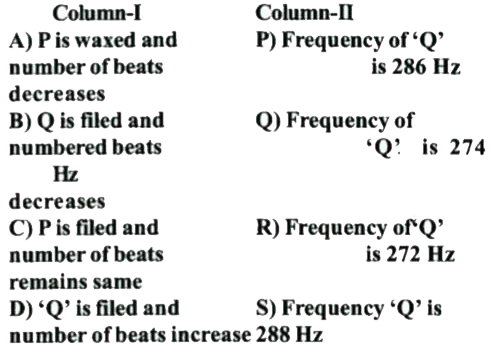Frequency of tuning fork A is 256 Hz. It produces 4 beats/second with tuning fork B. When wax is applied at tuning fork B then 6 beats/second are heard. Frequency of B is :-
250 Hz
260 Hz
252 Hz
(A) & (C) both may possible
The correct Answer is:C
To find the frequency of tuning fork B, we can follow these steps:
1. Identify the Given Data:
- Frequency of tuning fork A (f_A) = 256 Hz
- Beats produced with tuning fork B (initially) = 4 beats/second
- Beats produced after applying wax on tuning fork B = 6 beats/second
2. Understanding Beats:
- The number of beats per second is given by the absolute difference in frequencies of the two tuning forks.
- Therefore, the relationship can be expressed as:
|fA−fB|=Number of beats
3. Setting Up the Equation for Initial Beats:
- For the initial case (4 beats/second):
|256−fB|=4
- This gives us two possible equations:
1. 256−fB=4 → fB=256−4=252 Hz
2. fB−256=4 → fB=256+4=260 Hz
4. Possible Frequencies for B:
- From the above calculations, the possible frequencies for tuning fork B are:
- fB=252 Hz
- fB=260 Hz
5. Analyzing the Effect of Wax:
- When wax is applied to tuning fork B, it increases the mass and thus decreases its frequency.
- In this case, the number of beats increases to 6 beats/second:
|256−f′B|=6
- This gives us two new possible equations:
1. 256−f′B=6 → f′B=256−6=250 Hz
2. f′B−256=6 → f′B=256+6=262 Hz
6. Conclusion on Frequency of B:
- Since applying wax decreases the frequency of tuning fork B, we need to consider the case where the frequency of B was initially higher (260 Hz) and then decreased.
- Thus, the only feasible frequency for tuning fork B that satisfies both conditions (initially producing 4 beats and then 6 beats after applying wax) is:
fB=252 Hz
Final Answer:
The frequency of tuning fork B is 252 Hz.
---
- Frequency of tuning fork A (f_A) = 256 Hz
- Beats produced with tuning fork B (initially) = 4 beats/second
- Beats produced after applying wax on tuning fork B = 6 beats/second
- The number of beats per second is given by the absolute difference in frequencies of the two tuning forks.
- Therefore, the relationship can be expressed as:
|fA−fB|=Number of beats
- For the initial case (4 beats/second):
|256−fB|=4
- This gives us two possible equations:
1. 256−fB=4 → fB=256−4=252 Hz
2. fB−256=4 → fB=256+4=260 Hz
- From the above calculations, the possible frequencies for tuning fork B are:
- fB=252 Hz
- fB=260 Hz
- When wax is applied to tuning fork B, it increases the mass and thus decreases its frequency.
- In this case, the number of beats increases to 6 beats/second:
|256−f′B|=6
- This gives us two new possible equations:
1. 256−f′B=6 → f′B=256−6=250 Hz
2. f′B−256=6 → f′B=256+6=262 Hz
- Since applying wax decreases the frequency of tuning fork B, we need to consider the case where the frequency of B was initially higher (260 Hz) and then decreased.
- Thus, the only feasible frequency for tuning fork B that satisfies both conditions (initially producing 4 beats and then 6 beats after applying wax) is:
fB=252 Hz
The frequency of tuning fork B is 252 Hz.
Topper's Solved these Questions
- WAVES AND OSCILLATIONSBook:ALLENChapter:WAVES AND OSCILLATIONSExercise:Part-1(Exercise-02)
Explore 19 Videos
- WAVES AND OSCILLATIONSBook:ALLENChapter:WAVES AND OSCILLATIONSExercise:Part-1(Exercise-03)
Explore 31 Videos
- WAVES AND OSCILLATIONSBook:ALLENChapter:WAVES AND OSCILLATIONSExercise:Part-3(Example)
Explore 32 Videos
- SEMICONDUCTORSBook:ALLENChapter:SEMICONDUCTORSExercise:Part-3(Exercise-4)
Explore 51 Videos
Similar Questions
The frequency of tuning fork 'A' is 250Hz. It produces 6 beats/sec, when sounded together with another tunning fork B. If its arms are loaded with wax then it produces 4 beats/sec. Find the frequency of tuning fork B.
View SolutionA tuning fork A produces 5 beats/sec with another tuning fork B of frequency 256 Hz. If tuning fork A produces 1 beats/sec with some other tuning fork C of frequency 250 Hz, then calculate the frequency of fork A.
View Solution
Knowledge Check
The frequency of tuning fork is 256 Hz. It will not resonate with a fork of frequency
A768 HzB738 HzC512 HzD256 HzA tuning fork 'P' of frequency 280Hz produces 6 beats/s with unknown tuning fork 'Q'
 AABCDQRSRBABCDQRQPCABCDP.QQ.RR.SPDABCDR.SQ.RSR
AABCDQRSRBABCDQRQPCABCDP.QQ.RR.SPDABCDR.SQ.RSRA tuning fork A produces 4 beats/sec with another tuning fork B of frequency 320 Hz . On filing the fork A , 4 beats/sec are again heard. The frequency of fork A , after filing is
A324 HzB320 HzC316 HzD314 Hz
Tuning fork A of frequency 205 Hz produces 5 beats/sec with another fork B. After filing the tuning fork B, it produces 3 beats/sec with A. What was the frequency of the fork B before filling?
View SolutionA tuning fork vibrates with 2 beats in 0.04 second. The frequency of the fork is
View SolutionThe frequency of tuning fork A is 2% more than the frequency of a standard tuning fork. The frequency of a tuning fork B is 3% less than the frequency of the same standard tuning fork. If 6 beat/s are heard when the tuning fork A and B are excited , then frequency of A will be
View SolutionTurning fork A of frequency 305 Hz produces 5 beats s−1 with another turing fork B. After filling tuning fork B, it produces 3 beats s−1 with A. The frequency of B before filling was
View SolutionThe frequecies of tuning forks A and B are respectively 5% more and 3% less than the frequency of tuning fork C. When A and B are sounded together 8 beats/second are heard. Then the frequency of the tuning fork B will be
View Solution

